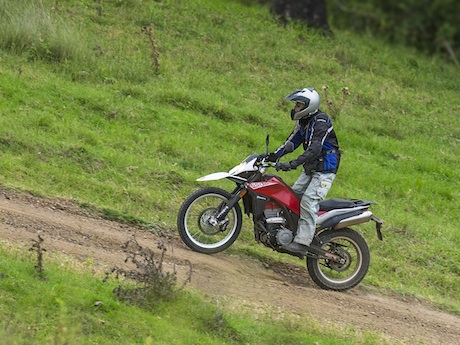Aussie racing car legend Kevin Bartlett has taken up the fight against “stupid” motorcycle laws that prevent riders from stretching their legs or standing up on the footpegs. Even Queensland Police Commissioner Ian Stewart has admitted to stretching his legs when riding.
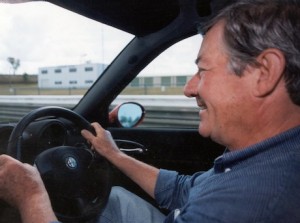
“It’s bullshit and ill-conceived,” says KB who is not one to mince words. “It’s got to be repealed. No use pussy-footing around and modifying it. There are other laws to stop any type of shenanigans. This is crap and you know that. Most bike people know it.”
The rule Kevin Bartlett (not the Aussie Rules legend but the two-time driver’s champ and ’74 Bathurst winner, “Big Rev Kev”) is referring to is Rule 271 in the national road rules also included in state road rules. Last month a Queensland rider was fined for stretching his legs while riding, causing a media sensation about police chasing petty offences to improve their “scorecard”. The Brisbane rider is not the first person to be fined for the offence and may not be the last.
To summarise the rule, riders must sit on the seat with their feet on the foot pegs at all times and at least one hand on the bars. The Australian Motorcycle Council has made a submission (featured in full below with the wording of Rule 271) to the National Transport Commission but has not yet received even an acknowledgement of its receipt, according to AMC secretary Tony Ellis.
Big Rev Kev is a long-time bike fan and reckons he is “on a mission”. He’s not waiting for the NTC to act on the AMC submission. “I’m on the Queensland Motorised Sports Council and we’ve got a meeting (February 25) with Assistant Police Commissioner Mike Keating and I am submitting a question on notice to him about this,” he says. “I’m a bike person and I’m sort of saying to the others on the council ‘you do the car stuff; I want to do the bike stuff’. I’m on a mission and if we can somehow change the idiot thinking on this I’ll feel that I’ve accomplished something.”
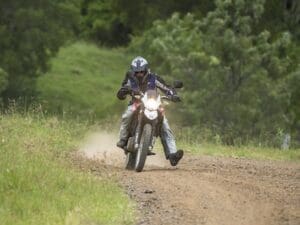
Kev has been riding motorbikes since 1955 and his shed currently includes a classic 1990 BMW R 100 GS Paris-Dakar, Yamaha XT500 and his “regular bike”, a BMW R 1200 GSA which replaced an R 1150 GSA. “Even when I ride to Phillip Island for the driver standards stuff (historic) I ride the bike and mainly do dirt roads. I do a lot of distance stuff and what we’re talking about here with this stupid rule is stuff that you and I live with all the time,” he says.
Kev rang me after reading my article about the rules, seeking my support for his push and the support of MotorbikeWriter readers before a meeting with Transport and Main Roads officials on March 6. “I want to put this forward as a formal request from our sports council and backed by as many people as I can get, otherwise it won’t get heard,” he says. “There is no use writing an email or a letter; it will just get swept under the carpet. This is a formal meeting with enough representatives from the TMR that it gets heard and tabled. There just might be a chance that we can get something moving on this. It’s been about seven years since it was introduced and it’s got to be stopped. I’ll be saying to them: ‘Be leaders in this. Don’t wait for the National Transport Commission. They will sit on their hands’.”
If you would like to show your support for KB’s push, leave a comment at the end of this story or send a personal email to Big Rev Kev at: kevrbart@gmail.com
OPINION
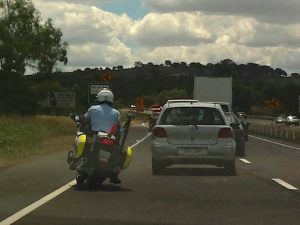
Kev asked for my opinion and for possible wording for an amendment. I sent him the Australian Motorcycle Council submission to the National Transport Commission for suggested wording, with some amendments. While I agree with most of the AMC submission, I don’t think it goes far enough on the footpeg issue. There are two concerns.
First, it doesn’t make any allowance for stretching the legs. Riders can get sudden cramps or, like me, suffer from sudden shooting pains in their knees. All we are asking for is a brief moment to stretch one leg at a time by taking a foot off the rider’s footpegs. This should be allowed at any time and at any speed. I’m not sure what definition they would require for a “moment” but I would consider 10 seconds more than enough. If they suggest that riders should stop to stretch, then they are jeopardising the safety of riders. There are many roads where it is unsafe to suddenly pull over. People have been killed when pulled over to the side of major highways. Also, there is the concern that while a rider continues to look for a safe place to pull over, the pain or cramp may lead them to a crash, resulting in injury or death.
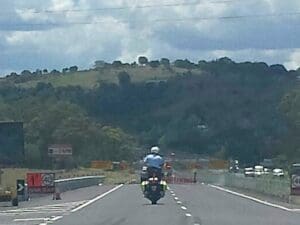
The other concern is that on dirt roads, it might be advisable to take one foot off the footpegs through a corner, motocross style. As you know, the bike can suddenly slip on gravel and if you aren’t allowed to put one foot down you could lose control and crash, also resulting in injury or death.
As for the “sitting astride” issue, I think it needs to be clearly spelt out that this issue has become more pertinent in recent years with the growing trend toward adventure bikes. In fact, it is the fastest-growing segment in the bike industry. For the past 10 years we have been watching Charley Boorman and Ewan McGregor in the “Long Way” series standing on the footpegs. Many riders have done the responsible thing and sought training for adventure riding and have been taught by the experts to stand as often as possible. To prevent riders from crashing and to avoid them having to unlearn a valid skill, this issue must be cleared up as soon as possible.
Owing to recent publicity about riders being penalised for these rules, many riders may be scared into sitting down, which could result in crashes, injury and possibly death. None of these scenarios are being over-dramatic. They are simple statements of truth. Do the bureaucrats want to be responsible for the injury or death of riders?
AMC SUBMISSION TO NTC
In general terms, there are three parts to Section (1) of this Rule that deal with rider control of a motorcycle, i.e. (a) sit on seat, (b) hands on handlebars, (c) feet on footpegs.
Rule 271: Riding on motor bikes
(1) The rider of a motor bike that is moving (other than a rider who is walking beside and pushing a motorbike), or the rider of a motorbike that is stationary but not parked, must:
(a) sit astride the rider’s seat facing forwards; and
(b) ride with at least 1 hand on the handlebars; and
(c) if the motorbike is moving — keep both feet on the footrests designed for use by the rider of the motorbike.
The proposed Amendments to Parts (b) and (c) are welcome.
For rules 271 (1) (b) and (c) substitute –
“(b) if the motorbike is moving – keep at least 1 hand on the handlebars; and
(c) if the motorbike is moving – keep both feet on the footrests designed for use by the rider of the motorbike, unless the motorbike is moving at less than 10 kilometres per hour and either:
(i) the rider is manoeuvring the motorbike in order to park the motorbike; or
(ii) the motorbike is decelerating to come to a stop; or
(iii) the motorbike is accelerating from being stopped.”.
We submit that Part (a) requires an Amendment to ensure a motorcycle rider is able to maintain control.
We propose that Part (a) of Section (1) be amended to read:
“(a) remain astride the motorbike facing forwards”
We reproduce here the text and photograph from Page 55 of the Victorian Riders’ Handbook, issued by VicRoads and available online, as “part 2”:
Bumpy roads and potholes
On rough roads, keep your speed down. That does three things – it gives you time to avoid
the worst bumps or holes, reduces road shocks and gives your bike’s suspension time to
work. Remember that bumps can affect your steering as well as well as the suspension, so
take it easy. To give yourself as much control as possible, raise yourself a little on the
footpegs so you can absorb road shocks with your knees and elbows.
On Page 57 of the same VicRoads Handbook is a “check your understanding” question for this point.
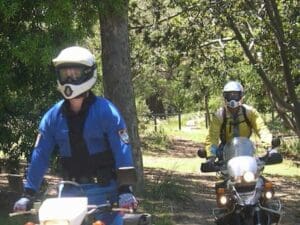
The following photograph shows a NSW Police rider demonstrating correct posture for maintaining precise control when riding on variable surface geometry:
Separating bodyweight from the motorcycle mass and applying it low-down through the footpegs aids in lowering the centre of mass for maneuvering control.
Similarly, we propose that Part (a) of Section (2) be amended to allow a pillion passenger to follow the body movement of the rider. This is particularly significant in negotiating “speed humps” or traffic calming devices placed on suburban roads. Speed humps may cause a pillion passenger to become unseated if they do not lift their body off the seat by standing on the footpegs.
We propose that Part (a) of Section (2) be amended to read:
“(a) remain astride the pillion seat facing forwards; and”
These amendments would clarify the existing rule and create consistency with motorcycle rider training and safety.


